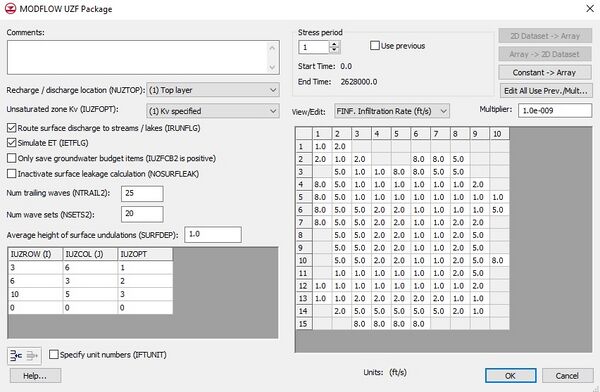GMS:UZF Package: Difference between revisions
From XMS Wiki
Jump to navigationJump to search
No edit summary |
No edit summary |
||
| (15 intermediate revisions by 3 users not shown) | |||
| Line 1: | Line 1: | ||
{{ | {{MODFLOW Links}} | ||
The UZF Package is used to simulate percolation of water through | [[File:MODFLOW-UZF.jpg|thumb|600 px|The ''MODFLOW UZF Package'' dialog.]] | ||
The Unsaturated Zone Flow (UZF) package is used to simulate percolation of water through an unsaturated zone. This package is only compatible in GMS with MODFLOW 2005, NWT, and LGR. | |||
The inputs to the UZF | The inputs to the UZF package are edited in the ''UZF Package'' dialog. The inputs to the UZF package are explained [https://water.usgs.gov/nrp/gwsoftware/modflow2000/MFDOC/uzf_unsaturated-zone_flow_pack.html here]. All of the inputs are labeled using the MODFLOW variable names. | ||
===Stress Periods=== | |||
The values displayed in the spreadsheet are for an individual stress period for the first 4 arrays (FINF, PET, EXTDP, and EXTWC). The other arrays are not specified per stress period. | |||
===Gages=== | ===Gages=== | ||
| Line 11: | Line 15: | ||
===Multiplier=== | ===Multiplier=== | ||
The multiplier is a constant which can be written to the package file with each array. Each value in the array is scaled by the multiplier as the array is imported to MODFLOW. | The multiplier is a constant which can be written to the package file with each array. Each value in the array is scaled by the multiplier as the array is imported to MODFLOW. | ||
The values associated with different stress periods can be edited by entering the ID of the desired stress period in the Stress period edit box. If the Use previous option is selected for a given stress period, the values from the previous stress period are used and the spreadsheet is not editable. | The values associated with different stress periods can be edited by entering the ID of the desired stress period in the Stress period edit box. If the Use previous option is selected for a given stress period, the values from the previous stress period are used and the spreadsheet is not editable. | ||
| Line 21: | Line 22: | ||
===2D Dataset → Array=== | ===2D Dataset → Array=== | ||
The '''2D Dataset → Array''' button brings up the Data Browser listing all of the current datasets associated with the current 2D grid. In order for this button to be active, the 2D grid must have the same number of rows and columns as the 3D grid. The selected dataset is copied to the recharge array. Datasets are typically generated with the 2D Scatter Point module. The 2D Scatter Point module can be used to interpolate from a scattered set of rainfall measurements to the cell locations. If the dataset is transient, the values in the dataset are linearly interpolated, if necessary, to each stress period as the dataset is copied to the array. | The '''2D Dataset → Array''' button brings up the ''Data Browser'' listing all of the current datasets associated with the current 2D grid. In order for this button to be active, the 2D grid must have the same number of rows and columns as the 3D grid. The selected dataset is copied to the recharge array. Datasets are typically generated with the 2D Scatter Point module. The 2D Scatter Point module can be used to interpolate from a scattered set of rainfall measurements to the cell locations. If the dataset is transient, the values in the dataset are linearly interpolated, if necessary, to each stress period as the dataset is copied to the array. | ||
===Array → 2D Dataset=== | ===Array → 2D Dataset=== | ||
| Line 27: | Line 28: | ||
===Spreadsheet=== | ===Spreadsheet=== | ||
The values for the array listed in the View/Edit selection box are shown in the spreadsheet. | The values for the array listed in the ''View/Edit'' selection box are shown in the spreadsheet. | ||
| Line 33: | Line 34: | ||
[[Category:MODFLOW]] | [[Category:MODFLOW]] | ||
[[Category:MODFLOW Packages]] | [[Category:MODFLOW Packages]] | ||
[[Category:MODFLOW Dialogs]] | |||
[[Category:External Links]] | |||
